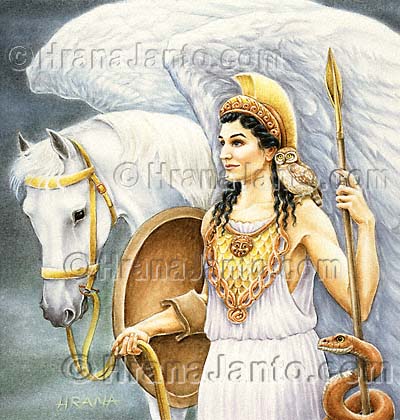 |
|
|||||
PREVIOUS | NEXT | A,B,C, D,E, F,G,H,I, J,K,L,M, N,O,P,Q, R,S, T,U,V,W,X,Y,Z | Help | ALL | INDEX
Hrana's Notes
I painted Athena in 2000 for Llewellyn's 2001 Goddess Calendar.| Athena from Goddesses and Heroines |
Exerpt from Goddess & Heroines by Patricia
Monaghan [Used by permission. This text is NOT included in the Goddess Oracle] |
She was not always accepted as patron of the famous city that bears her name. Greek legend says that the sea god Poseidon disputed with the goddess for ruler ship of the city. It came to a vote of the people of the town in question. The citizens, men and women alike, gathered to cast their ballots. Naturally the men voted for the god, the women for the goddess. As it happened, there was one more voter on the women's side, and Athena won the day. (An alternative version says that the Olympian deities judged the contest. They ruled that because Athena had planted the first olive tree, whereas all Poseidon could offer was the changeful sea, the goddess would be a better ruler than the god.
The men of Athens bitterly agreed to accept the goddess as their patron.
But being poor losers, the levied three heavy requirements on the women:
that they should forego being called citizens, that they should no longer
vote, and that their children should be called by their father's names.
They then prepared a new identity for the city's goddess. They claimed
that she was a virginal goddess without sexuality, a motherless goddess
who sprang full grown from the head of Zeus, who had swallowed her mother
Metis. This Athena was "all for the father" (as Aescheylus has
her say), who voted on the side of the new patriarchal order against the
earlier system of mother right. But hidden in the legend of the Athenian
vote are clues to Athena's original identity. If children did not bear
their mothers' names, if women were not full citizens, if women did not
vote, why bother to legislate against it?
There was yet another version of the birth of Athena, one that is far
less flattering to male divinity. This story says that she was the daughter
of Pallas, a winged giant. He tried to rape his virginal daughter, so
she killed him. She tanned his skin to make a shield and cut off his wings
to fasten to her feet. Another myth in which Athena's virginity is threatened
says that Hephaestus, the smith god, attempted to rape her, but only managed
to ejaculate on her leg. The goddess wiped it off in disgust. But the
semen touched all-fertile Gaia, whereupon a half-serpent boy named Erichthonius
was born. Athena accepted the boy as her offspring and gave him to the
Augralids to guard.
A curious part of this relatively obscure story is the shaky nature of
the boy. As Hephaestus had no known reptile ancestors, it must be that
Athena provided the serpent blood. Her intimate connection with Medusa,
whose snake-haired visage Athena wears on her goat-skin cloak called the
aegis, is also relevant. Similarly, the massive snake that reared beside
her statue in the Parthenon, her major temple on the Athenian Acropolis,
suggests that the snake was one of the primary symbols of the virgin goddess.
It is now well established that Athena--her name is so ancient that it
has never been translated--was originally a Minoan or Mycdenaean household
goddess--possibly related to the bare-breasted Cretan figures seen embracing
snakes or holding them overhead. This original Athena was the essence
of the family bond, symbolized by the home and its hearth--and by the
mild serpent, who-- like the household cat, lived in the storehouse and
protected the family's food supplies against destructive rodents. As household
goddess, Athena ruled the implements of domestic crafts: the spindle,
the pot, and the loom. By extrapolation, she was the guardian of the ruler's
home, the goddess of the palace; by further extrapolation, she was the
symbol of the community itself, the larger social unit based on countless
homes.
Although Minoan civilization declined, Athena was not lost. A maiden goddess,
apparently called Pallas, arrived with the Greeks; she was a warrior,
a kind of Valkyrie, a protector of the tribe. This figure was bonded to
that of the indigenous tribal symbol to form Pallas Athena, and her legend
was re-created to suit the new social order. But Athena's ritual reflected
her origins. Each year midsummer her splendid image was taken from her
temple on the Acropolis and borne ceremoniously down to the sea. There
Athena was carefully washed and, renewed in strength and purity, was decked
in a newly made robe woven by the city's best craftswomen. It was the
same ritual that honored Hera and showed Athena as a woman's deity--the
mistress of household industry and family unity.
| Back to TOP | Published by Llewellyn, copyright 1997. Used by permission of the author. |